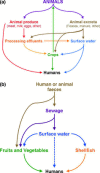Virus hazards from food, water and other contaminated environments
- PMID: 22091646
- PMCID: PMC7114518
- DOI: 10.1111/j.1574-6976.2011.00306.x
Virus hazards from food, water and other contaminated environments
Abstract
Numerous viruses of human or animal origin can spread in the environment and infect people via water and food, mostly through ingestion and occasionally through skin contact. These viruses are released into the environment by various routes including water run-offs and aerosols. Furthermore, zoonotic viruses may infect humans exposed to contaminated surface waters. Foodstuffs of animal origin can be contaminated, and their consumption may cause human infection if the viruses are not inactivated during food processing. Molecular epidemiology and surveillance of environmental samples are necessary to elucidate the public health hazards associated with exposure to environmental viruses. Whereas monitoring of viral nucleic acids by PCR methods is relatively straightforward and well documented, detection of infectious virus particles is technically more demanding and not always possible (e.g. human norovirus or hepatitis E virus). The human pathogenic viruses that are most relevant in this context are nonenveloped and belong to the families of the Caliciviridae, Adenoviridae, Hepeviridae, Picornaviridae and Reoviridae. Sampling methods and strategies, first-choice detection methods and evaluation criteria are reviewed.
© 2011 Federation of European Microbiological Societies. Published by Blackwell Publishing Ltd. All rights reserved.
Figures


References
-
- Adlhoch C, Wolf A, Meisel H, Kaiser M, Ellerbrok H & Pauli G (2009) High HEV prevalence in four different wild boar populations in East and West Germany. Vet Microbiol 139: 270–278. - PubMed
-
- AFNOR (1990) AFNOR XP T 90‐451 Recherche des entérovirus. AFNOR, Dartford.
Publication types
MeSH terms
LinkOut - more resources
Full Text Sources
Medical

